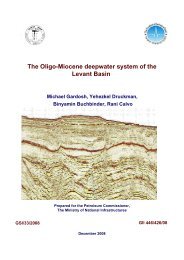tivity on the carmel faul
tivity on the carmel faul
tivity on the carmel faul
You also want an ePaper? Increase the reach of your titles
YUMPU automatically turns print PDFs into web optimized ePapers that Google loves.
terrain (see ch. 1.4- Geological setting of Carmel regi<strong>on</strong>), yet no direct evidence of<br />
slope movement in <strong>the</strong> area of Denya Cave was found to date. Landslides were<br />
documented mostly <strong>on</strong> <strong>the</strong> nor<strong>the</strong>astern slopes of <strong>the</strong> Carmel.<br />
The eliminati<strong>on</strong> of <strong>the</strong>se points allows for <strong>the</strong> working hypo<strong>the</strong>sis that earthquakes<br />
caused <strong>the</strong> observed damage to speleo<strong>the</strong>ms in Denya Cave.<br />
1.3 Dating of Speleo<strong>the</strong>ms<br />
In <strong>the</strong> 238 U radioactive decay-series a state of secular equilibrium between parent and<br />
daughter nuclides is established in any naturally occurring material that has remained<br />
undisturbed for several milli<strong>on</strong> years because <strong>the</strong> half-life of <strong>the</strong> parent isotope is much greater<br />
than that of <strong>the</strong> intermediate daughters in <strong>the</strong> decay chain. The decay-series in sec<strong>on</strong>dary<br />
deposits formed from <strong>the</strong> dissoluti<strong>on</strong> and subsequent precipitati<strong>on</strong> of such material, however,<br />
will be in a state of disequilibrium at time of formati<strong>on</strong>, with ei<strong>the</strong>r an excess or deficiency of<br />
intermediate nuclides because of fracti<strong>on</strong>ati<strong>on</strong> processes. The extent to which it has returned to<br />
secular equilibrium in a closed system from an initial state of disequilibrium can be expressed<br />
by a straightforward functi<strong>on</strong> of time using <strong>the</strong> decay c<strong>on</strong>stants if <strong>the</strong> following criteria are<br />
satisfied: (1) intermediate and daughter decay products at time of formati<strong>on</strong> were absent, or if<br />
present, can be corrected for; (2) no gain or loss of <strong>the</strong> parent nuclide or daughter products<br />
occurred since <strong>the</strong> time of formati<strong>on</strong> (Richards and Dorale, 2003).<br />
U-series dating of speleo<strong>the</strong>ms is based <strong>on</strong> <strong>the</strong> extreme fracti<strong>on</strong>ati<strong>on</strong> of <strong>the</strong> parent 238 U<br />
isotope from its l<strong>on</strong>g-lived daughter 230 Th in <strong>the</strong> hydrosphere. The average abundances of U<br />
and Th in <strong>the</strong> earth’s c<strong>on</strong>tinental crust are 1.7 and 8.5 µg/g respectively (Wedepohl, 1995).<br />
Their relative abundances in <strong>the</strong> hydrosphere are different principally because of <strong>the</strong>ir differing<br />
solubility in surface and near surface envir<strong>on</strong>ments (Richards and Dorale, 2003).<br />
U is readily mobilized in <strong>the</strong> meteoric envir<strong>on</strong>ment, principally as <strong>the</strong> highly soluble<br />
Uranyl i<strong>on</strong> (UO 2+ 2 ). The l<strong>on</strong>g-lived daughter product Th exists in a +4 oxidati<strong>on</strong> state and is<br />
readily hydrolyzed and ei<strong>the</strong>r precipitated or absorbed <strong>on</strong> detrital particulates. It can <strong>the</strong>refore<br />
be readily transported with <strong>the</strong> result that waters feeding sec<strong>on</strong>dary calcite deposits will<br />
generally have negligible Th c<strong>on</strong>centrati<strong>on</strong>s. In a closed system, <strong>the</strong> extent to which 230 Th/ 238 U<br />
ac<str<strong>on</strong>g>tivity</str<strong>on</strong>g> (a) ratios have returned to unity is a functi<strong>on</strong> of time (t).<br />
Calcite speleo<strong>the</strong>ms can be dated accurately by U-series disequilibrium techniques under<br />
specific c<strong>on</strong>diti<strong>on</strong>s: (1) when <strong>the</strong> system remained closed to <strong>the</strong> additi<strong>on</strong> or removal of U or Th<br />
nuclides to <strong>the</strong> lattice; (2) when <strong>the</strong> deposit is younger than ~500,000y; (3) when <strong>the</strong>re is a<br />
sequential stratigraphic layering al<strong>on</strong>g <strong>the</strong> growth axis; (4) when <strong>the</strong>re is no initial Th in <strong>the</strong><br />
14

















